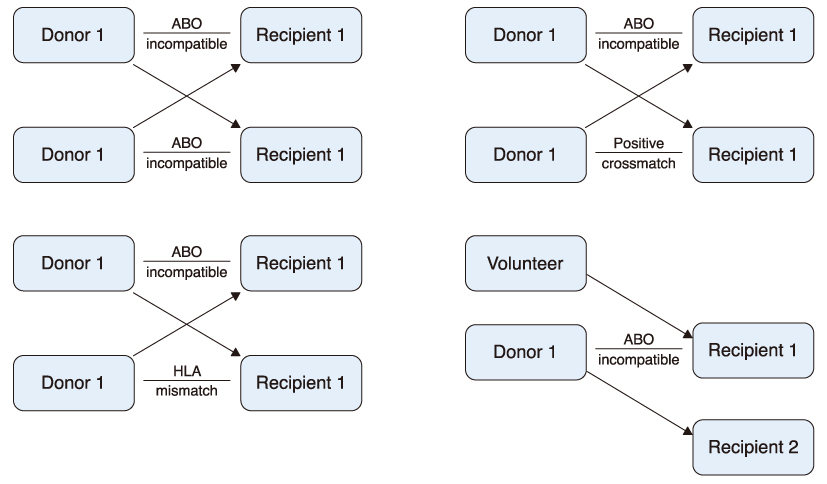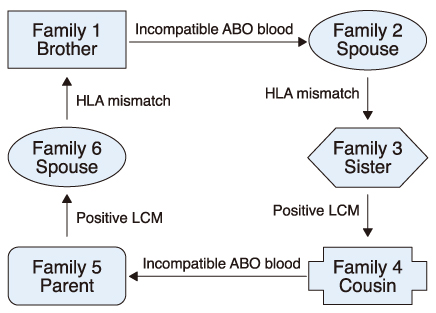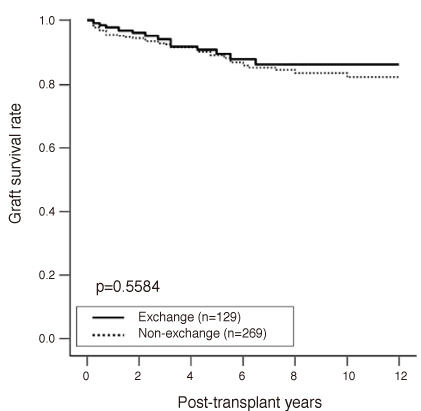J Korean Med Assoc.
2008 Aug;51(8):717-723. 10.5124/jkma.2008.51.8.717.
Exchange Living-donor Kidney Transplantation: The Present and Future
- Affiliations
-
- 1Department of Surgery, Yonsei University College of Medicine, Korea. yukim@yuhs.ac
- 2Department of Internal Medicine, Yonsei University College of Medicine, Korea.
- KMID: 2185929
- DOI: http://doi.org/10.5124/jkma.2008.51.8.717
Abstract
- The shortage of donor organs is one of the major barriers of transplantation worldwide. After the success of the direct exchange donor (swap) program in Korea since 1991, a swaparound program has been developed. Recently, a web-based (computerized) algorithm to facilitate donor kidney exchange was devised and tested in multi-center settings. An excellent longterm outcome was achieved by using the donor exchange program as an option to reduce the donor organ shortage. Herein, we discussed on the current status of the exchange donor renal transplantation in Korea, a couple of problems we have had, and future directions we have to head and make better to improve organ donation activities.
Keyword
MeSH Terms
Figure
Reference
-
1. Kim SI, Kwon KH, Huh KH, Lee JH, Kim YS, Park K. Experience with cyclosporine in adult living donor kidney transplantation: from 1984 to 2002 at Yonsei University. Transplant Proc. 2004. 36:186S–192S.
Article2. 2006 Annual Report. Korean Network for Organ Sharing (KONOS) web data. Accessed June 2008. Available at: http://www.konos.go.kr.3. Rapaport FT. The case for a living emotionally related international kidney donor exchange registry. Transplant Proc. 1986. 18:5–9.4. Kwak JY, Kwon OJ, Lee KS, Kang CM, Park HY, Kim JH. Exchange-donor program in renal transplantation: a single-center experience. Transplant Proc. 1999. 31:344–345.
Article5. Park K, Moon JI, Kim SI, Kim YS. Exchange donor program in kidney transplantation. Transplantation. 1999. 67:336–338.6. Huh KH, Kim MS, Ju MK, Chang HK, Ahn HJ, Lee SH, Lee JH, Kim SI, Kim YS, Park K. Exchange living-donor kidney transplantation: Merits and limitations. Transplantation. 2008. 86:(In press).
Article7. Schweitzer EJ, Wilson JS, Fernandez-Vina M, Fox M, Gutierrez M, Wiland A, Hunter J, Farney A, Philosophe B, Colonna J, Jarrell BE, Bartlett ST. A high panel-reactive antibody rescue protocol for cross-match-positive live donor kidney transplants. Transplantation. 2000. 70:1531–1536.
Article8. Montgomery RA, Zachary AA, Racusen LC, Leffell MS, King KE, Burdick J, Maley WR, Ratner LE. Plasmapheresis and intravenous immune globulin provides effective rescue therapy for refractory humoral rejection and allows kidneys to be successfully transplanted into cross-match-positive recipients. Transplantation. 2000. 70:887–895.
Article9. Glotz D, Antoine C, Julia P, Suberbielle-Boissel C, Boudjeltia S, Fraoui R, Hacen C, Duboust A, Bariety J. Desensitization and subsequent kidney transplantation of patients using intravenous immunoglobulins (IVIg). Am J Transplant. 2002. 2:758–760.
Article10. Gloor JM, Lager DJ, Moore SB, Pineda AA, Fidler ME, Larson TS, Grande JP, Schwab TR, Griffin MD, Prieto M, Nyberg SL, Velosa JA, Textor SC, Platt JL, Stegall MD. ABO-incompatible kidney transplantation using both A2 and non-A2 living donors. Transplantation. 2003. 75:971–977.
Article11. Tanabe K, Tokumoto T, Ishida H, Ishikawa N, Miyamoto N, Kondo T, Shimmura H, Setoguchi K, Toma H. Excellent outcome of ABO-incompatible living kidney transplantation under pretransplantation immunosuppression with tacrolimus, mycophenolate mofetil, and steroid. Transplant Proc. 2004. 36:2175–2177.
Article12. Ross LF, Rubin DT, Siegler M, Josephson MA, Thistlethwaite JR Jr, Woodle ES. Ethics of a paired-kidney-exchange program. N Engl J Med. 1997. 336:1752–1755.
Article13. Kaplan I, Houp JA, Montgomery RA, Leffell MS, Hart JM, Zachary AA. A computer match program for paired and unconventional kidney exchanges. Am J Transplant. 2005. 5:2306–2308.
Article14. Saidman SL, Roth AE, Sonmez T, Unver MU, Delmonico FL. Increasing the opportunity of live kidney donation by matching for two - and three-way exchanges. Transplantation. 2006. 81:773–782.
Article15. Kim BS, Kim YS, Kim SI, Kim MS, Lee HY, Kim YL, Kim CD, Yang CW, Choi BS, Han DJ, Kim YS, Kim SJ, Oh HY, Kim DJ. Outcome of multipair donor kidney exchange by a web-based algorithm. J Am Soc Nephrol. 2007. 18:1000–1006.
Article16. de Klerk M, Witvliet MD, Haase-Kromwijk BJ, Claas FH, Weimar W. A highly efficient living donor kidney exchange program for both blood type and crossmatch incompatible donor-recipient combinations. Transplantation. 2006. 82:1616–1620.
Article
- Full Text Links
- Actions
-
Cited
- CITED
-
- Close
- Share
- Similar articles
-
- The Outcome of Renal Transplantation Using Exchange Donor Program
- The Results of Spousal Donor Kidney Transplantation Via Exchange Donor Program and Direct Spousal Donor Kidney Transplantation in Living Donor Kidney Transplantation: Single Center Experience
- Exchange-donor Program in Renal Transplantation: A single center experience
- Evaluation of the Recipient and Donor in Living Kidney Transplantation
- Kidney Transplantation after ex vivo Repair of an Aneurysm of the Donor Renal Artery





